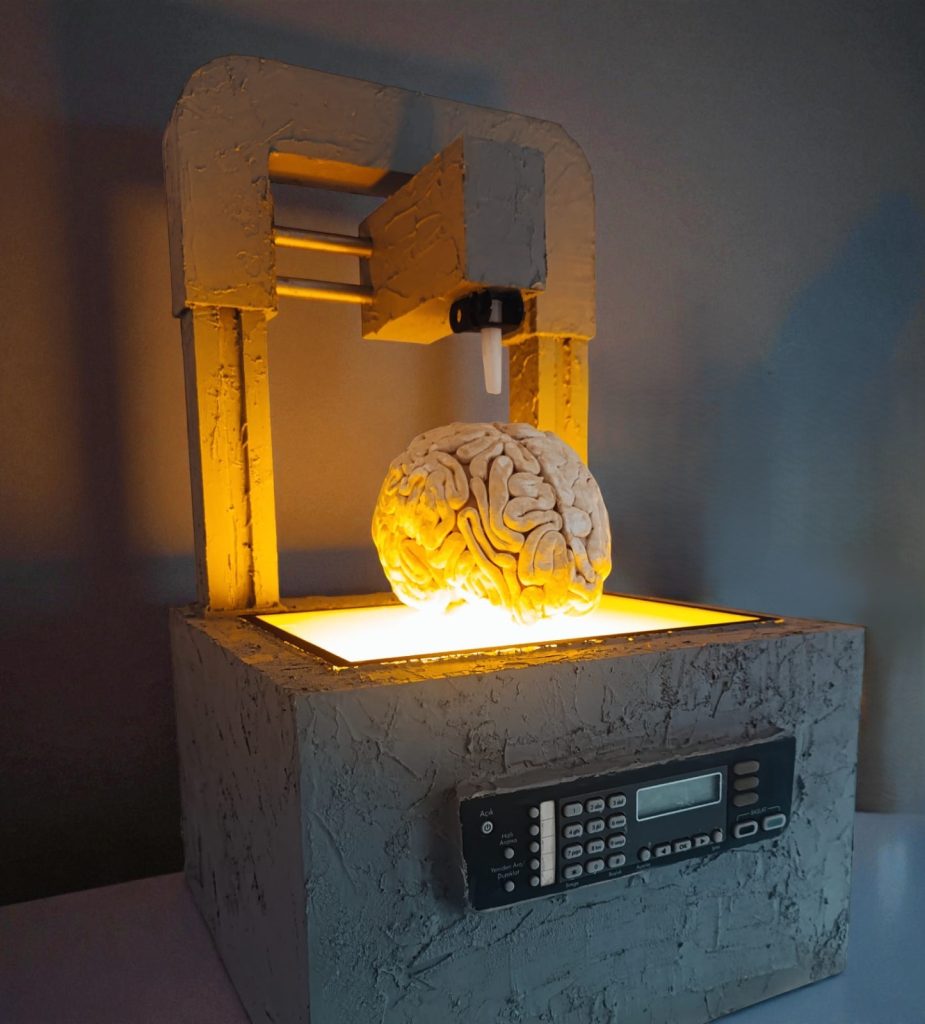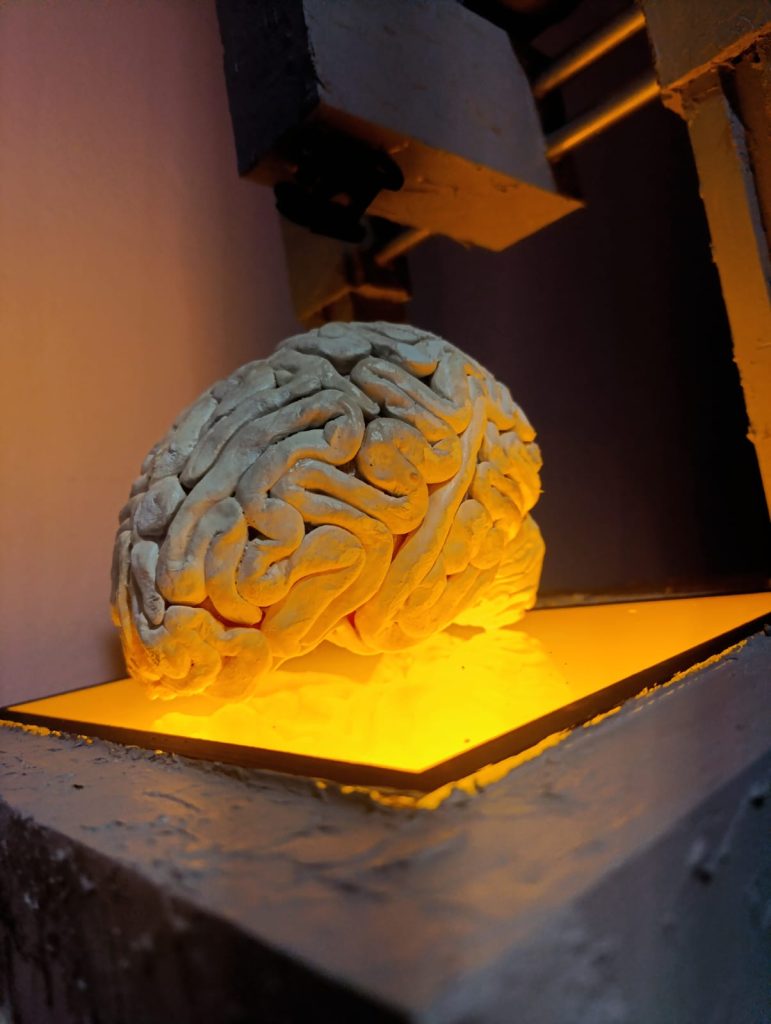MUHARREM ÖZDEMİR (Kahramanmaraş, 1996)
Düzce Üniversitesi, Heykel Bölümū
Bilinç İmalatı / Production of Consciousness, 2025
Heykel, karışık teknik, 40x40x70 cm
Sculpture, mixed technical, 40x40x70 cm
Bu heykel formu, sadece bir araç olarak değil, aynı zamanda bilinç formunun yeni bir uzantısı olduğunu sorgulayan teknolojinin somutlaşmış halidir. İnsanlığın yapay zekâya, biyoteknolojiye ve dijital ölümsüzlüğe duyduğu derin arzuyu yansıtan bu yapı, “Bilinç İmalatı” kavramını merkezine alır.
İnsan düşüncesi artık soyut bir kavram olmaktan çıkmış, üretilebilir bir maddeye dönüşmüştür. Bu, kendimizi yeniden üretme, hatta kopyalama isteğimizin teknoloji aracılığıyla somutlaştığı bir süreçtir. Marshall McLuhan’ın “Medyayı Anlamak: İnsanın Uzantıları” (Understanding Media:Extensions of Man) adlı eserinde “araçlar, insan uzuvlarının uzantılarıdır” şeklindeki görüşüyle, teknolojinin insan bedeninin ve zihninin bir uzantısı olduğunu savunmuştur. Bu açıdan bakıldığında makineler, düşüncemizin ve yaratıcılığımızın sınırlarını zorlayan mekanizmalarsa, o halde onlar, zihinsel süreçlerimizin uzamsal ve mekanik bir devamı olarak görülmelidir. Bu bağlamda, makineler sadece araçlar değil, insanlığın bilincini somutlaştıran uzuvlarıdır.
This sculptural form embodies technology, questioning its role not merely as a tool but as a new extension of the form of consciousness. Reflecting humanity’s profound desire for artificial intelligence, biotechnology, and digital immortality, this structure centers on the concept of “Consciousness Manufacturing.”
Human thought is no longer an abstract concept but a manufacturable substance. This is a process in which our desire to reproduce, even replicate, ourselves is embodied through technology. In his work “Understanding Media: Extensions of Man,” Marshall McLuhan argued that technology is an extension of the human body and mind, arguing that “tools are extensions of human limbs” (McLuhan, 1994: 3). From this perspective, if machines are mechanisms that push the boundaries of our thought and creativity, then they should be viewed as a spatial and mechanical continuation of our mental processes. In this context, machines are not just tools, but limbs of humanity that embody its consciousness.
Sanatçı ve eserle ilgili daha fazla bilgi almak için info@base.ist adresine e-posta atmanızı rica ederiz.
Bu heykel formu, sadece bir araç olarak değil, aynı zamanda bilinç formunun yeni bir uzantısı olduğunu sorgulayan teknolojinin somutlaşmış halidir. İnsanlığın yapay zekâya, biyoteknolojiye ve dijital ölümsüzlüğe duyduğu derin arzuyu yansıtan bu yapı, “Bilinç İmalatı” kavramını merkezine alır.
İnsan düşüncesi artık soyut bir kavram olmaktan çıkmış, üretilebilir bir maddeye dönüşmüştür. Bu, kendimizi yeniden üretme, hatta kopyalama isteğimizin teknoloji aracılığıyla somutlaştığı bir süreçtir. Marshall McLuhan’ın “Medyayı Anlamak: İnsanın Uzantıları” (Understanding Media:Extensions of Man) adlı eserinde “araçlar, insan uzuvlarının uzantılarıdır” şeklindeki görüşüyle, teknolojinin insan bedeninin ve zihninin bir uzantısı olduğunu savunmuştur. Bu açıdan bakıldığında makineler, düşüncemizin ve yaratıcılığımızın sınırlarını zorlayan mekanizmalarsa, o halde onlar, zihinsel süreçlerimizin uzamsal ve mekanik bir devamı olarak görülmelidir. Bu bağlamda, makineler sadece araçlar değil, insanlığın bilincini somutlaştıran uzuvlarıdır.
This sculptural form embodies technology, questioning its role not merely as a tool but as a new extension of the form of consciousness. Reflecting humanity’s profound desire for artificial intelligence, biotechnology, and digital immortality, this structure centers on the concept of “Consciousness Manufacturing.”
Human thought is no longer an abstract concept but a manufacturable substance. This is a process in which our desire to reproduce, even replicate, ourselves is embodied through technology. In his work “Understanding Media: Extensions of Man,” Marshall McLuhan argued that technology is an extension of the human body and mind, arguing that “tools are extensions of human limbs” (McLuhan, 1994: 3). From this perspective, if machines are mechanisms that push the boundaries of our thought and creativity, then they should be viewed as a spatial and mechanical continuation of our mental processes. In this context, machines are not just tools, but limbs of humanity that embody its consciousness.
Sanatçı ve eserle ilgili daha fazla bilgi almak için info@base.ist adresine e-posta atmanızı rica ederiz.




